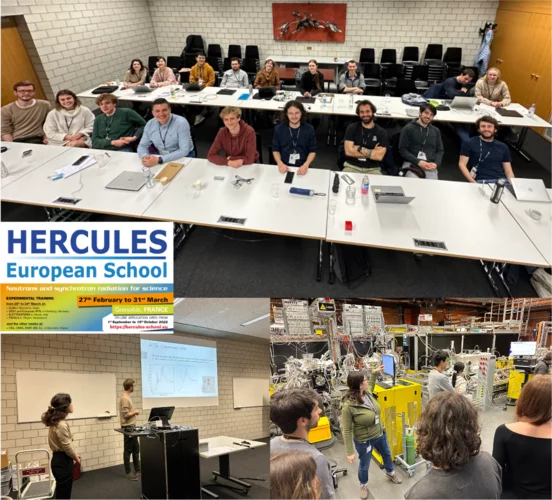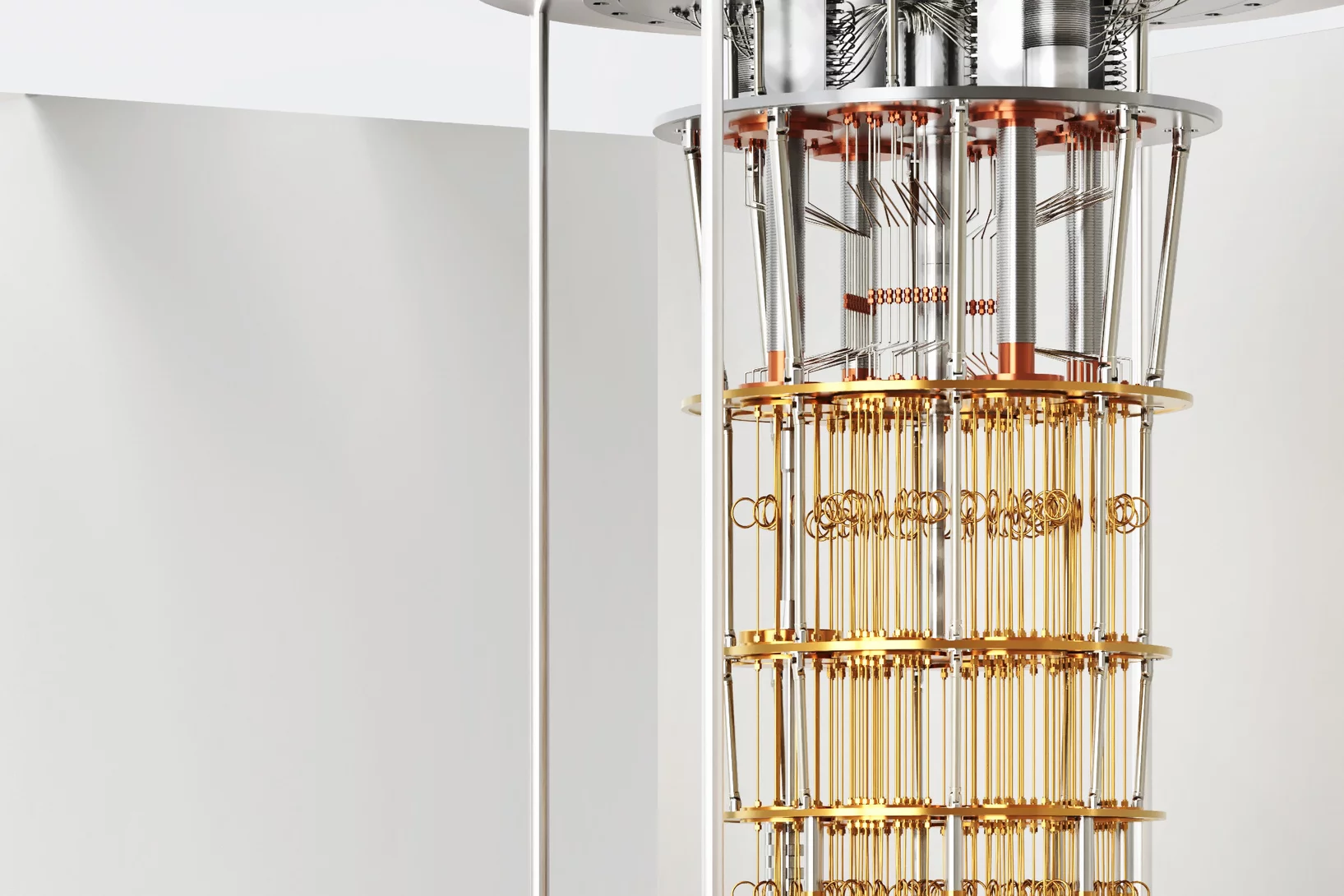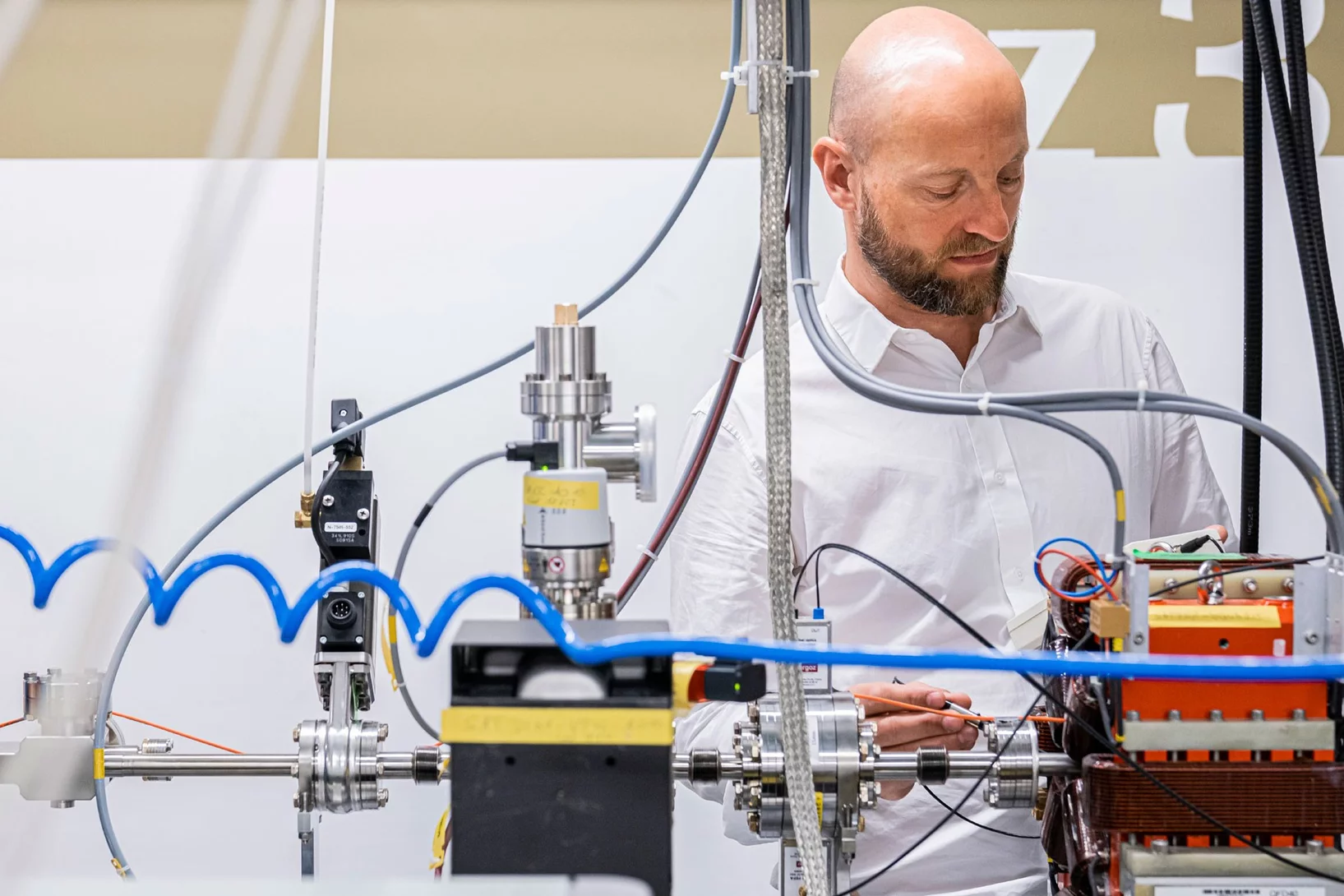Nobel Prize winner Anne L’Huillier visits SwissFEL
X-ray free-electron lasers could unlock the next frontier in attosecond research
Controlling magnetic waves in a spin liquid
Scientists at the Paul Scherrer Institute PSI have shown that excitation of a spin liquid with intense THz pulses causes spins to appear and align within less than a picosecond. This induced coherent state causes a magnetic field to form inside the material, which is detected using ultrashort X-ray pulses at the X-ray Free Electron Laser SwissFEL.
Grundlegend anders
Künstliche Intelligenz hilft dabei, unvorstellbar grosse Datenmengen effizient auszuwerten und das volle Potenzial der Grossforschungsanlagen auszuschöpfen.
Short x-ray pulses reveal the source of light-induced ferroelectricity
Ultrafast measurements of the fluctuating atomic positions in the quantum paraelectric SrTiO3 after mid-infrared light excitation, reveal details about the creation of the material’s ferroelectric state.
SwissFEL: a next generation tool for Attosecond Science
The 2023 Nobel Prize in Physics recognises attosecond science’s pioneers. Past and future, this field’s evolution is entwined with SwissFEL.
Erbschäden mit Sonnenlicht reparieren
Ein internationales Forschungsteam hat am SwissFEL des PSI aufgeklärt, wie ein Enzym mithilfe von Sonnenlicht DNA-Schäden repariert.
The secret life of an electromagnon
SwissFEL sheds light on how lattice and atomic spins jiggle together.
SwissFEL leuchtet für industrielle Anwender
Dank Hochdurchsatzexperimenten können neue Nutzergruppen aus der Strukturbiologie vom XFEL-Licht profitieren.
Tender X-rays show how one of nature’s strongest bonds breaks
Short flashes of an unusual kind of X-ray light at SwissFEL and SLS bring scientists closer to developing better catalysts to transform the greenhouse gas methane into a less harmful chemical.
A compact gas attenuator for the SwissFEL ATHOS beamline realized using additive manufacturing
Gas attenuators are important devices providing accurate variation of photon intensity for soft X-ray beamlines. In the SwissFEL ATHOS beamline front-end the space is very limited and an innovative approach has been taken to provide attenuation of three orders of magnitude up to an energy of 1200 eV. Additive manufacturing of a differential pumping system vacuum manifold allowed a triple pumping stage to be realized in a space of less than half a meter. Measurements have shown that the response of the device is as expected from theoretical calculations.
Ein Algorithmus für schärfere Protein-Filme
Mit einem neu entwickelten Algorithmus lassen sich Messungen an Freie-Elektronen-Röntgenlasern effizienter auswerten.
The Hercules School visits PSI
20 international students visited PSI as part of the renowned Hercules School to learn about our state-of-the-art techniques and methodologies at our large scale facilities.
So beginnt das Sehen
PSI-Forschende haben untersucht, was als Allererstes im Auge abläuft, wenn Licht auf die Netzhaut trifft.
Medikamente mit Licht an- und abschalten
Forschende des PSI drehen einen molekularen Film eines Krebsmedikaments mit Lichtschalter. Das eröffnet neue Einblicke für Wirkstoffentwickler.
Hightech-Unternehmen VDL ETG wird Nachbar des PSI
Das niederländische Unternehmen VDL ETG hat einen Mietvertrag mit dem Park Innovaare unterzeichnet.
3,1 Millionen Förderung für neue Forschungsprojekte am PSI
Die beiden PSI-Forschenden Zurab Guguchia und Kirsten Schnorr erhalten vom Schweizerischen Nationalfonds Förderbeiträge von insgesamt 3,1 Millionen CHF für zukunftsweisende Projekte.
Strong modulation of carrier effective mass in WTe2 via coherent lattice manipulation
Schematic ultrafast surface diffraction setup used for monitoring the crystal lattice in multiple directions.
Ein Stück PSI-Geschichte geht auf grosse Fahrt
Auf zu neuen Ufern – eine Hightech-Komponente vom PSI befindet sich auf dem Seeweg nach Australien und soll künftig im Australian Synchrotron in Melbourne zum Einsatz kommen.
Lösung für das Unlösbare
PSI und ETH Zürich haben den Quantum-Computing-Hub gegründet. Spitzenforschende arbeiten dort gemeinsam an Konzepten für Quantencomputer.
Athos just got even better
An ambitious upgrade at the soft X-ray beamline of the free electron laser SwissFEL opens up new experimental capabilities.
Schneller und smarter
Das PSI bündelt seine Expertise bezüglich der Auswertung von Forschungsdaten im neuen Forschungsbereich Computergestützte Wissenschaften, Theorie und Daten.
New SwissFEL soft X-ray endstation welcomes first users
Maloja is go. First user experiments mark a double first, not only for the Maloja endstation but also for the second beamline of SwissFEL, Athos.
Hercules School 2022
PSI hosted again the Hercules School in March 2022. We had the pleasure to welcome 20 international PhD students, PostDocs and scientists to demonstrate our state-of-the-art techniques and methodologies at our large scale facilities, the Swiss Light Source (SLS), the Swiss Spallation Neutron Source (SINQ) and our free electron laser SwissFEL.
Die wundersame Welt der Lichtantennen
Wie man mit Lichtrezeptoren Prozesse in Zellen gezielt an- und abschalten kann.
Opening the door to X-ray quantum optics
The 'perfect' X-ray beam-splitter: Researchers at SwissFEL have an ingenious solution to produce coherent copies of pulses, facilitating a realm of new X-ray techniques.
Priority access call for work on combating COVID-19 continues
On January 30th, 2020, the WHO declared the recent outbreak of coronavirus disease 2019 (COVID-19), a public health emergency of international concern. It declared that there is an urgent need to improve our understanding of the newly identified virus and its possible future evolution as well as to contain the spread; to develop precise diagnostics and treatment, and to improve the public health response and patient care.
The COVID priority access call continues and is still open in 2022.
Anomalous temperature dependence of the experimental x-ray structure factor of supercooled water
Supercooled water scattering signals show an anolmalous structure factor temperature dependence suggesting decreasing density at lowering temperatures below 236 K (-37°C).
Overview of SwissFEL dual-photocathode laser capabilities and perspectives for exotic FEL modes
SwissFEL is a compact, high-brilliance, soft and hard X-ray Free Electron Laser (FEL) facility laser composed of two parallel beam lines seeded by a common linear accelerator (LINAC), and a two-bunch photo-injector. For the injector, an innovative dual-photocathode laser scheme has been developed based on state-of-the-art Ytterbium femtosecond laser systems. We just published an overview of the the SwissFEL Photo Cathode Drive Lasers (PCDL) performance, pulse shaping capabilities as well as the versatility of the systems, which allow many different modes of operation of SwissFEL [1]. The full control over the SwissFEL electron bunch properties via the unique architecture of the PCDL will enable in the future the advent of more advanced FEL modes; these modes are, but not restricted to, the generation of single or trains of sub-fs FEL pulses, multi-color FEL and finally the generation of fully coherent X-ray pulses via laser-based seeding.
Ultraschnelle Kontrolle von Quantenmaterialien
Mit Licht die Eigenschaften von Festkörpern grundlegend verändern
Ultrafast electron localization
This experiment performed at SwissFEL shows how fast we can localize electrons out of an electron gas into correlated, well localized states of a material. It is based on a combined ultrafast x-ray absorption and diffraction experiment on an intermetallic system.





























